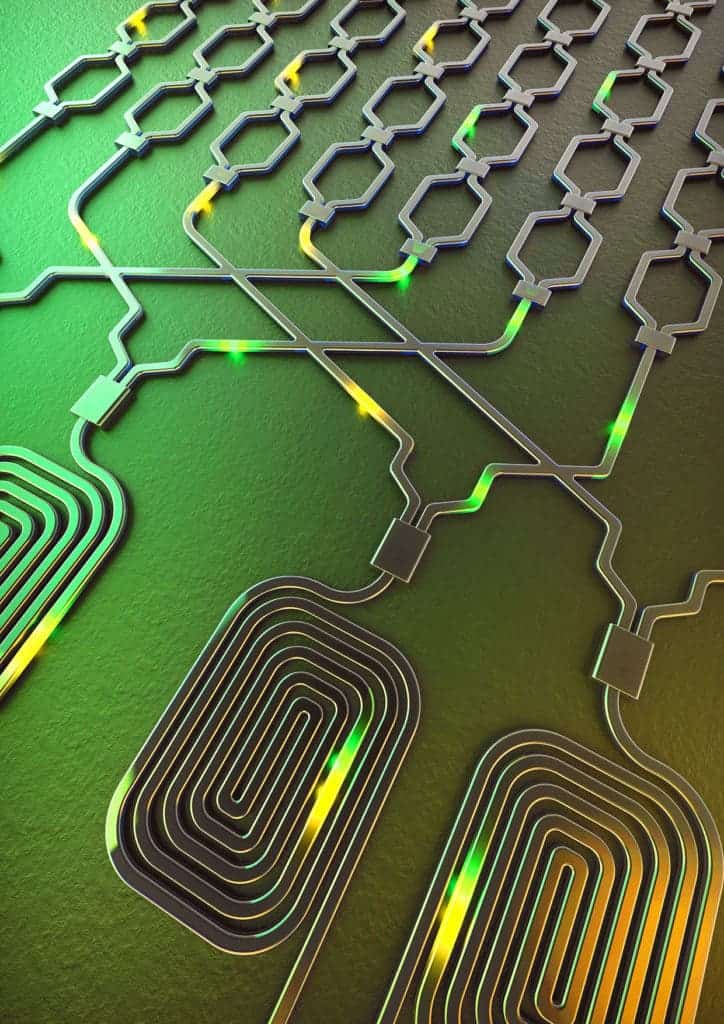Physicists have demonstrated a silicon chip that is capable of manipulating individual photons, thereby enabling a quantum photonic processor.

In normal silicon computer chips embedded into your laptop or smartphone, information is rendered in one of two states: 0 or 1. In a quantum computer, a quantum bit (or qubit) can also be stored and relayed in both states at once, holding exponentially more information.
Two qubits can perform operations on four values, three on eight values and so on in powers of two — they can do that simultaneously, whereas traditional bits have to assume a position. As such, a quantum computer could be billions of times faster than a normal silicon computer built on a von Neumann architecture. As an analogy, imagine being able to read a whole library at once rather than one book at a time.
By one estimate, a quantum computer with 50 quantum bits would be more powerful in solving quantum sampling problems than today’s fastest supercomputer. Quantum computers are able to crunch through big data problems that involve finding optimum solutions from vast numbers of options, which is extremely important for a number of medical fields (i.e. protein folding, gene sequencing) and climate research, but also security (one of the biggest selling points for quantum computers). A hacker can make a copy of your email now without you ever knowing; a hack of a quantum system, however, is bound by the laws of physics to leave traces.
According to McKinsey & Company, in 2015, there were about 7,000 researchers worldwide working in the field, with about US$1.5 billion a year being spent. But despite the scale of the industry’s effort to put a quantum computer on the market, progress is rather slow.
The most qubits companies such as IBM or Google have managed to achieve is a few dozens. Most of these machines run on superconducting wires, which are chilled near to absolute zero. The problem is that the qubits of electrons interact with basically everything and it is incredibly challenging to avoid quantum decoherence (collapse of wavefunction and qubit). However, in another approach to quantum computer design, atoms are held in place not by chilling temperatures but by lasers.
Unlike electrons, photons do not interact with the environment, so there are no short coherence time issues. On top of that, photons can be manipulated with high precision and travel as fast as anything can, at the speed of light.
At the same time, the fact that photons just pass through each other also makes it impossible for scientists to use a simple way to implement quantum operations as they would with superconducting machines.
Now, researchers at the University of Bristol may have found an elegant solution. They devised a silicon photonic chip which split photons into different spatial modes, guiding them along set paths. The chip is made up of numerous interferometers which are responsible for splitting the photons into different modes, where each mode passes through a specific waveguide. Basically, this maze of interferometers acts as a single gate.
To demonstrate their device’s capabilities, the researchers implemented 98 different two-qubit gates, performing about 1,000 measurements for each set. Operations completed successfully around 93% of the time, which is comparable with other types of quantum computing around the world. Superconducting quantum computers, for instance, have a rate of completion of around 90% to 95%. The team even ran an optimization algorithm on the photon chip.
Remarkably, from a single laser light source, the chip generates pairs of photonic qubits. The challenge in the future will be to figure out how to generate many more identical and entangled photons. The hardware currently used is fine for two qubits, but for hundreds you would need a totally different configuration. For instance, the photon detector was placed outside the chip. What’s more, fitting enough phase shifters and beam splitters to accommodate hundreds of qubits sounds daunting right now, but the scientists are confident they can do it.
The findings appeared in the journal Nature Photonics.


